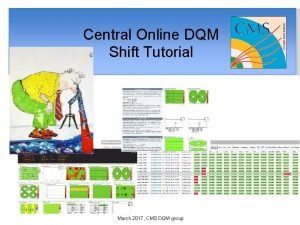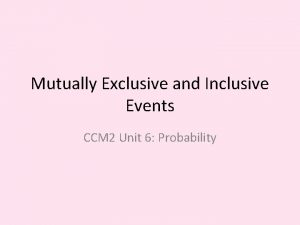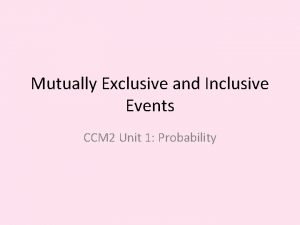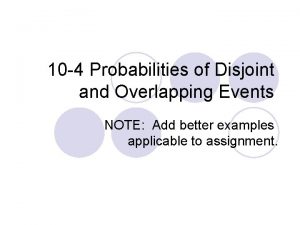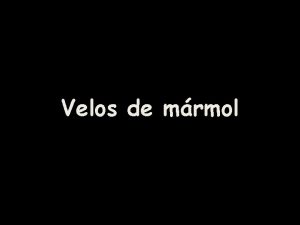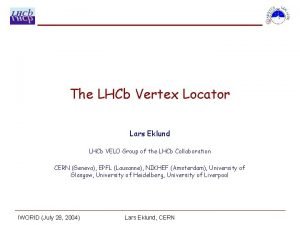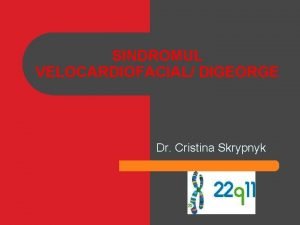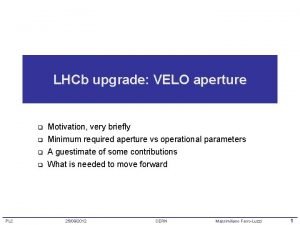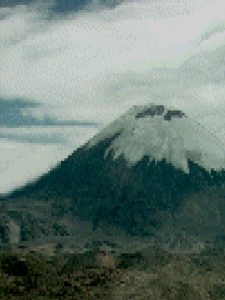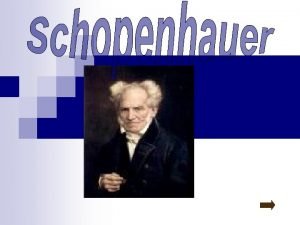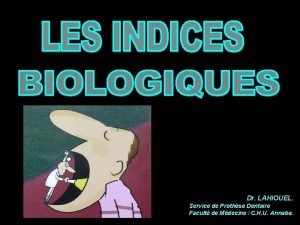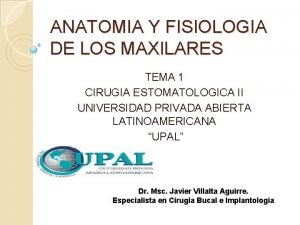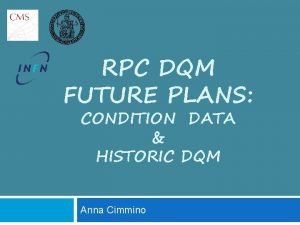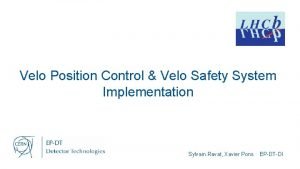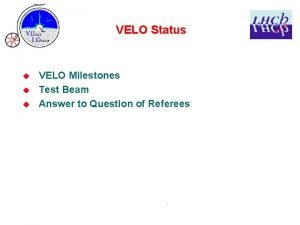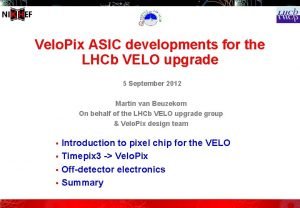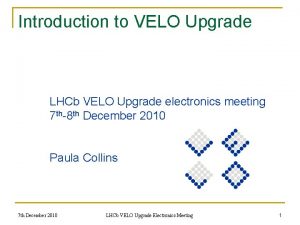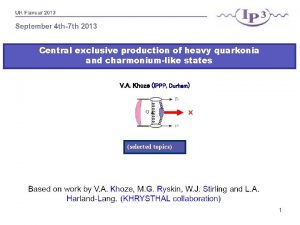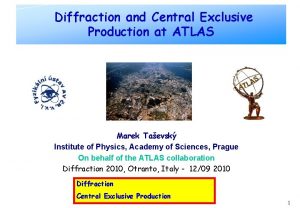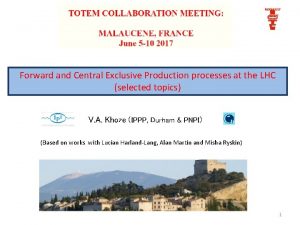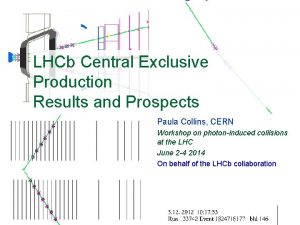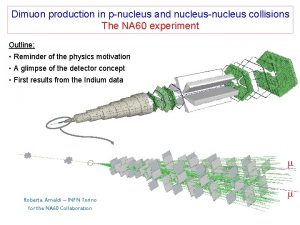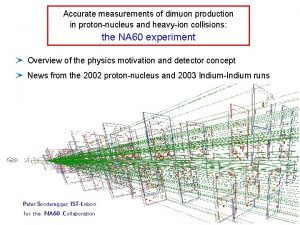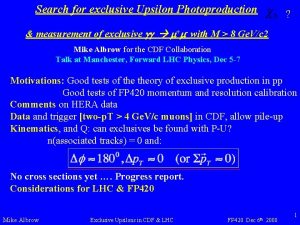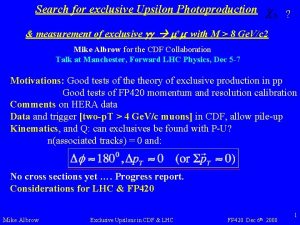VELO DQM and Central Exclusive Dimuon Production at


















- Slides: 18

VELO DQM and Central Exclusive Dimuon Production at LHCb Ciarán Hickey (University College Dublin) Summer Student Sessions, August 16 th 2011 1

Outline 1. Brief introduction to LHCb and the VErtex LOcator (VELO) 2. Update of VELO DQM TWiki and GUI 3. Analysis of central exclusive dimuon production at LHCb Summer Student Sessions, August 16 th 2011 2

The LHCb Experiment RICH detectors Calorimeters Trackers VErtex LOcator (VELO) Magnet Muon chambers Scintillating pad detector (SPD) Summer Student Sessions, August 16 th 2011 3

The VELO detector • Silicon strip detector made up of 2 retractable halves of 21 modules each • Each module has both an r and φ sensor • Needed to precisely locate both primary and secondary vertices Summer Student Sessions, August 16 th 2011 4

VELO Data Quality Monitoring • A number of macros are used to produce plots detailing VELO performance during a run. • The plots are usually (and most easily) accessed from the VELO monitoring GUI. Summer Student Sessions, August 16 th 2011 5

Update to VELO GUI TWiki page • There are 16 tabs in the GUI using a total of 20 macros • Updated/wrote documentation for each macro including: – A summary of plots produced by the macro – Usage – Ideal behaviour – Examples of ideal and bad plots – Known problems Summer Student Sessions, August 16 th 2011 6

Update to the monitoring GUI Summer Student Sessions, August 16 th 2011 7

Update to the monitoring GUI Summer Student Sessions, August 16 th 2011 8

Update to the monitoring GUI Summer Student Sessions, August 16 th 2011 9

Update to the monitoring GUI Summer Student Sessions, August 16 th 2011 10

Update to the monitoring GUI Summer Student Sessions, August 16 th 2011 11

3. Analysis of Central Exclusive Dimuon Production at LHCb (carried out with G. P. Mc. Gread, University of Cambridge) Summer Student Sessions, August 16 th 2011 12

What is central exclusive dimuon production? • Central = Particles are produced far from the beam line • Exclusive = Class of reactions whereby the colliding particles remain intact. Additional particles are produced by photon and/or gluon propogators, i. e. A + B → A + X + B • Dimuon = Two muons, a μ+μ- pair, are produced • At LHCb we are studying: p + p → p + μ+μ- + p • Examples: Summer Student Sessions, August 16 th 2011 13

Online cuts to the data • Hardware Trigger Settings: – Less than 10 SPD hits. – Single muon with a transverse momentum, pt > 400 Me. V/c 2 or two muons both with pt > 80 Me. V/c 2. • Software Trigger Settings: – Invariant mass of dimuon candidate is > 1 Ge. V/c 2 and its pt < 900 Me. V/c 2 or its mass is > 2. 7 Ge. V/c 2. Summer Student Sessions, August 16 th 2011 14

Offline cuts • Red = All dimuon candidates passing the triggers • Blue = Required that; the number of long tracks = 2, number of backward tracks = 0 and the pseudorapidity is in the range 2<η<4. 5 • Green = Additional requirement that the total number of tracks = 2 Summer Student Sessions, August 16 th 2011 15

Dimuon Invariant Mass Spectrum Summer Student Sessions, August 16 th 2011 16

Invariant Mass Distributions of J/Ψ and Ψ(2 S) • J/Ψ: – Gaussian fit gives mean of 3090. 9± 0. 3 Me. V/c 2 – PDG value of mass is 3096. 916± 0. 011 Me. V/c 2 • Ψ(2 S): – Gaussian fit gives mean of 3678± 3 Me. V/c 2 – PDG value of mass is 3689. 09± 0. 04 Me. V/c 2 Summer Student Sessions, August 16 th 2011 17

Conclusions • We can see clear signals of ψ(2 S), J/ψ, φ and ρ, ω from 2011 LHCb data. • More analysis needed in order to determine the exclusivity of these events. • It is also necessary to calculate the efficiencies, purity, effective luminosity and background so that the cross sections can be calculated, σ = (p. N)/(εLeff). • Special thanks to Dr. Ronan Mc. Nulty, Stephen Farry and Gráinne Mc. Gread. Summer Student Sessions, August 16 th 2011 18
 Cms dqm
Cms dqm Mutually exclusive vs non mutually exclusive
Mutually exclusive vs non mutually exclusive Sebutkan alur produksi multimedia
Sebutkan alur produksi multimedia Central idea of the production
Central idea of the production Exclusive and inclusive math
Exclusive and inclusive math Mutually exclusive and exhaustive events
Mutually exclusive and exhaustive events Probability mutually exclusive
Probability mutually exclusive P (a/b) formula
P (a/b) formula Examples of disjoint events
Examples of disjoint events Virgen con velo escultura
Virgen con velo escultura Velo locator
Velo locator Sindrom velo cardio facial
Sindrom velo cardio facial Motivation velo
Motivation velo Leyenda el velo de la novia chile
Leyenda el velo de la novia chile Velo di maya schopenhauer
Velo di maya schopenhauer Velo di maya significato
Velo di maya significato Agrément accompagnateur vélo
Agrément accompagnateur vélo Ligne faitiere des cretes
Ligne faitiere des cretes Conductos nutricios dentales
Conductos nutricios dentales
